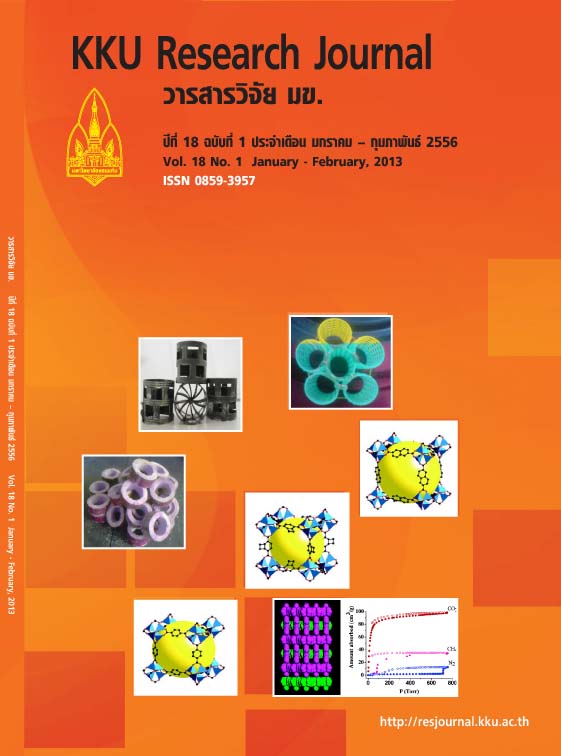A comparison of methods for measuring soil moisture characteristic curve
Main Article Content
Abstract
Accurate soil water flow modeling is not possible without a corrected soil moisture characteristic curve. At present, the curve is determined by 4 popular methods namely tension disc infiltrometer, Beerkan method, evaporation and pedo-transfer function. Since these 4 methods have never been compared therefore this study compares the accuracy and advantage among the methods. The soils located in a para rubber plantation in Phra Yun District, Khon Kaen Province were chosen for the comparison. We found that the Beerkan and the evaporation gave reasonable and consistant results, while the tension disc infiltrometer gave too low the negative pressure head (NPH) and the pedo-transfer function gave too high NPH values. However, the Beerkan is simpler and cheaper than the evaporation.
Article Details
References
[2] Sriboonlue, V. Hydrology. Khon Kaen: Khon Kaen University. 2009. Thai.
[3] Mualem, Y. A new model for predicting the hydraulic conductivity of unsaturated porous media. Water Resour. Res. 1976;12: 513-522.
31KKU Res. J. 2013; 18(1)
[4] Perroux, K.M. and I White. Design for disc permeameters and soil dispersion. Soil Sci. Soc. Am. J. 1988;48: 50-55.
[5] Harverkamp, R.; F.J. Leij, C. Fuentes, A. Sciortino and P.J. Ross. Soil water retention: I. Introduction of a shape index. Soil Sci. Soc. Am. J. 2005;69: 1881-1890.
[6] Wind G.P. Capillary conductivity data estimated by a simple method. Proceedings of the Wageningen symposium; 1968 June, IASH Gentbrugge/Unesco Paris.
[7] Arya, L.M., F.J. Leij, M.Th. van Genuchten and P.J. Shouse. Scaling parameter to predict the soil water characteristic from particle-size distribution data. Soil Sci. Soc. Am. J. 1999;63: 510-519.
[8] Gardner, W.R. Some steady state solution of the unsaturated moisture fl ow equation with the application to evaporation from water table. Soil Sci. 1958;85: 228-232.
[9] Burdine, N.T. Relative permeability calculation from pore size distribution data. Petr. Trans. Am Inst. Min. Metall. Eng. 1953;198: 71-77.
[10] Xu, X., G. Kiely and C. Lewis. Estimation and analysis of soil hydraulic properties through infi ltration experiments: comparison of BEST and DL fi tting method. Soil Use and Management.DOI: 10.1111/j.1475-2743.2009.00218.x. 2009.
[11] Lassabatere, L., R. Angulo-Jaramillo, J.M.S. Ugalde, R. Cuenca, I. Braud and R. Haverkamp. Beerkan estimation of soil transfer parameters through infi ltration experiments-BEST. Soil Sci. Soc. Am. J. 2006; 70: 521-532.
[12] Guymon, G.L. Unsaturated Zone Hydrology.New Jersey: PTR Prentice Hall. 1994.
[13] Rocha D., F. Abbasi and J. Feyen. Sensitivity analysis of soil hydraulic properties on subsurface water flow in furrows. J. Irrig. Drain Eng. 2006;132 (4): 418-424.
[14] ISO. Soil Quality-Determination of the Unsaturated Hydraulic Conductivity and Water Retention Characteristic -Wind’s Evaporation Method. ISO 11275. 2004


